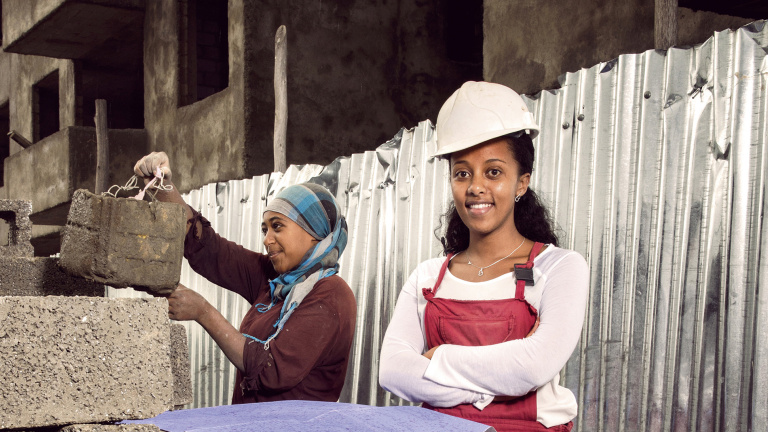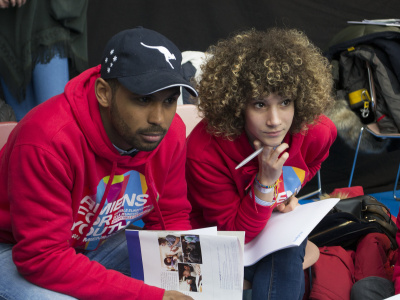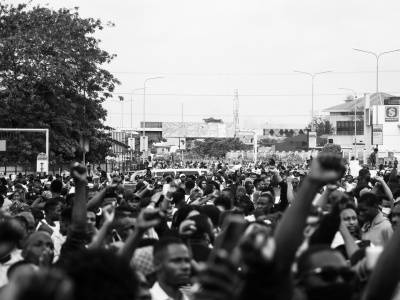
Complex paths: Supporting mixed livelihoods in fragile states
As in most fragile states, traditional concepts of ‘employment’ as a singular state do not apply in Liberia. Instead, many young people navigate complex livelihoods, earning income from multiple sources. The implications of these ‘portfolios of work’ are outlined below.
What does ‘employment’ mean in fragile states?
In 2003, a World Bank report estimated unemployment in Liberia to be as high as 85%, a figure which continues to be cited in major reports and economic outlook assessments (BTI, 2014, Liberia Country Report). Less than a decade later, an International Labour Organization (ILO) Labour Force Survey in Liberia concluded that the unemployment rate was only 3.7% (2011, Report on the Liberia Labour Force Survey 2010). How is this possible? Had Liberia achieved the most remarkable employment shift in documented history over the course of eight years? Unfortunately not – this discrepancy comes from two widely differing definitions of employment.
One of these – correlating with the 85% figure – is based on a definition of employment based on contracts, formality, and fulltime work; things which largely don’t exist in economies of fragile states like Liberia. The other – associated with the 3.7% figure – is based on a definition which includes any work at all, paid or unpaid, and inclusive of short-term work. Clearly, these black-and-white definitions do not help us understand the complexity of the situation on the ground. So what does employment for youth really look like in Liberia?
Findings from an initial sample of participants in the baseline survey of ‘Prospects’, a youth employment programme implemented in Liberia by the international NGO Mercy Corps with support from the Swedish Embassy (see www.prospectsliberia.com for more information) provide some insights. While just 0.7% reported having a full-time job with a written contract, fully 80% had some form of income from work-related activities. Unemployment of respondents could therefore be understood either at as much as 99.3%, or as little as 20%, depending on definitions. Those 80% are certainly not ‘employed’ in the sense that the term is commonly understood (with stable income and regular hours), but they are not fully unemployed, either. In fact as many as 46% of youth that reported one form of income had had two (or more) income sources. ‘Employment’ is therefore not a simple definition in Liberia and, we need better ways of understanding it.
‘Portfolios of work’ and ‘mixed livelihoods’
The aforementioned findings from Liberia mirror an emerging discussion characterised by growing acknowledgement that modern youth ‘employment’ in fragile states and many emerging economies is more complex and dynamic than rigid definitions allow for. Young people are engaged in a variety of income generating-activities at any one time, straddling the formal, informal and agricultural sectors, including family and micro-enterprises.
In a recent Working Paper, Chris Blattman and Laura Ralston define this livelihood strategy of combining multiple simultaneous income-generating activities as a ‘portfolio of work’ (2015, Generating employment in poor and fragile states). This portfolio approach, which the same authors assess as ‘the best response to a bad situation’, has arisen in fragile states for multiple reasons including: lack of full-time formal jobs; an equally clear lack of marketable skills for such jobs; imperfect hiring practices; and a high prevalence of seasonal earning opportunities. In addition, for youth who perceive temporary education as the biggest opportunity for economic mobility, part-time work to support studies may be essential, though it may be a means to an end rather than these youths’ ultimate objective.
It should be emphasised, though, that this mixed livelihood is not purely a coping strategy, but rather increasingly a proactive employment strategy. Recent research in Ghana and Uganda using livelihood diary methods has suggested that the portfolio approach suits the aspirations of young people today, who are attracted by the flexibility of mixed livelihoods and their ability to evolve within equally changeable contexts. Speaking at the Young Africa Works Summit, in Cape Town in 2015, Anne Marie van Swinderen from the research company L-IFT, explained, ‘Almost everyone is juggling income sources. . . mixed livelihoods is almost an identity.’ While the more developed economies are noticing an increasing movement towards the ‘gig economy’, those navigating mixed livelihoods in unstable economies in Africa are masters at it. The narrative of a single pathway out of poverty, via the attainment of a formal job, is therefore becoming increasingly obsolete for young Africans.
Implications for design and evaluation of youth employment programmes
The recognition of mixed livelihoods requires programme implementers to consider how both programme design and evaluation systems can respond to this emerging trend.
For programme design
Actors working on youth employment, particularly in fragile states, need to recognise that their employment interventions are unlikely to truly stimulate a linear employment trajectory as often outlined in theories of change; indeed many ‘unemployed’ participants or beneficiaries are actually already navigating some form of livelihood, albeit an unsatisfactory one. Varied young people need diverse supports to take their mixed livelihoods in different directions, and some may require more support than others: one youth may require increased technical skills which can be provided through vocational training or an on-the-job training scheme; others may require different interventions, such as business skills training or access to financial products. Moreover, those with much weaker portfolios might need a greater suite of supports to improve their status or overcome certain hurdles. This is not to mention the common variances both in aspirations and needs according to gender, age, and disability, among other variables. Accommodating these diversities in status and aspirations are critical to successful intervention; efforts to commit participants to a singular channel of training in an expectation that all youth are ‘unemployed’ could even risk damaging their existing income portfolio as well as detract from their non-economic obligations (such as educational commitments).
A recent (2016) systematic review of youth employment programmes by the Institute for the Study of Labor (IZA) for the World Bank (of which half the sample were for programmes in weaker economies) found that only 30% were successful, and that even within those successful programmes the impact was often modest. There is therefore a clear need to rethink youth employment programming in fragile states, based on a more thorough understanding of mixed livelihoods. The systematic review found, for example, that programmes which integrate multiple interventions are more likely to have a positive impact.
Mercy Corps’ Prospects programme in Liberia is an example of an initiative which is structured to respond to the diverse needs and aspirations of young people with mixed livelihoods. The programme operates through demand-driven principles, with youth accessing a range of employment services (up to 40 are available) through walk-in Youth Opportunity Centres. Programme staff advise youth on services available in their area so youth are then able to undertake one or a range of activities, offered continuously and at differing schedules so participants are able to fit their livelihood portfolio growth around their existing responsibilities. More research is required to best understand how youth employment programmes can most effectively respond to the complexity of working with youth with mixed livelihoods. Part of this comes from needing a better understanding of the impact of such programmes on complex portfolios of work.
For programme evaluation
With this deeper understanding of mixed livelihoods, we recognise that outcomes resulting from employment programmes might occur in a range of areas, from the total and regularity of income earned, the number of days worked, the type and growth potential of livelihoods, satisfaction, or any combination of other areas. Moreover, changes in one area may result in contradictory changes in others; one individual’s improvement in his/her work stability by connecting to a formal job may result in lower pay. Further still, priorities and changes are likely to look very different for different people.
This complexity can create challenges for reporting programme impact to donors – a simple figure of ‘jobs created’ is replaced with a complex narrative of different changes which, as Blattman and Ralston (2014) observe, are ‘less glamorous and more difficult to quantify’. Moreover, this complexity can also create challenges for youth employment programme staff – what is the ‘north star’ of impact that the programme is aiming at? Recognizing complexity is fruitless unless we are able to make sense of what to do with it.
Mercy Corps’ 5-country youth employment partnership with The Coca-Cola Africa Foundation, Youth Empowered for Success! (YES!), has sought to respond to this challenge by determining a more operational understanding of what impact of youth employment programming looks like on mixed livelihoods. YES! looks at three ‘domains of change’ in measuring impact:

Each of these domains looks different between and within country contexts and encompasses a range of livelihood characteristics as presented above. In some contexts, ‘skills’ are also included as a low-level outcome, as this is potentially a critical long-term asset. This conceptualisation enables presentation of complex change in a simple fashion to a range of audiences, while also enabling programme teams to maintain a clear outcome-orientation.
Conclusion
Young people in fragile states have increasingly complex livelihoods. ‘Silver bullet’ or one-size-fits-all solutions, which imagine singular trajectories of economic empowerment, are unlikely to fully respond to the wider context in which youth live. Implementers and policymakers are likely to have to envision a more flexible and evolving set of services. Donors will need to provide space and flexibility to allow implementers to make this possible. Strong monitoring and evaluation systems can help provide valuable insights into what is working (and what isn’t) and can provide some clarity in navigating this uncertain terrain.
About the authors
Chris Maclay is Program Director/Youth Empowered for Success, Mercy Corps. John Skelton is Monitoring, Evaluation and Learning Manager, Mercy Corps.
Read the full magazine issue





